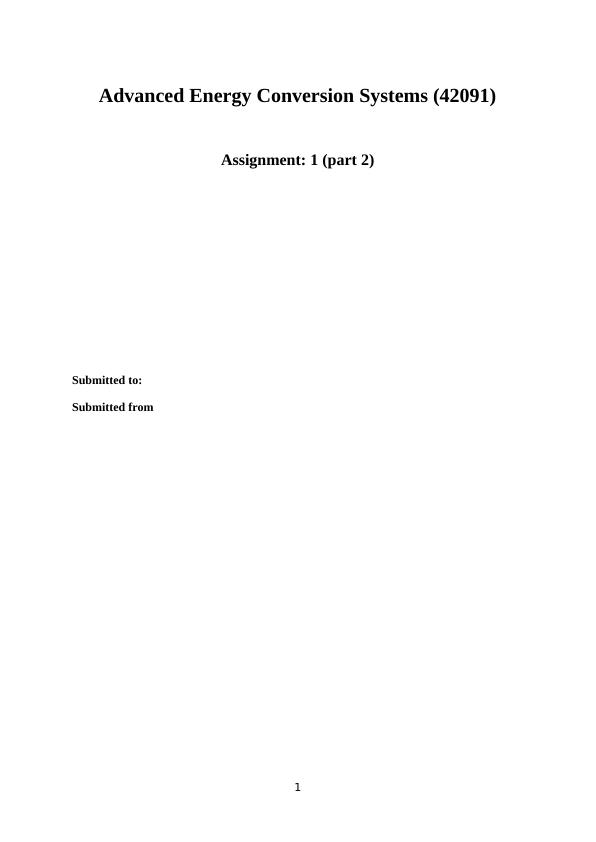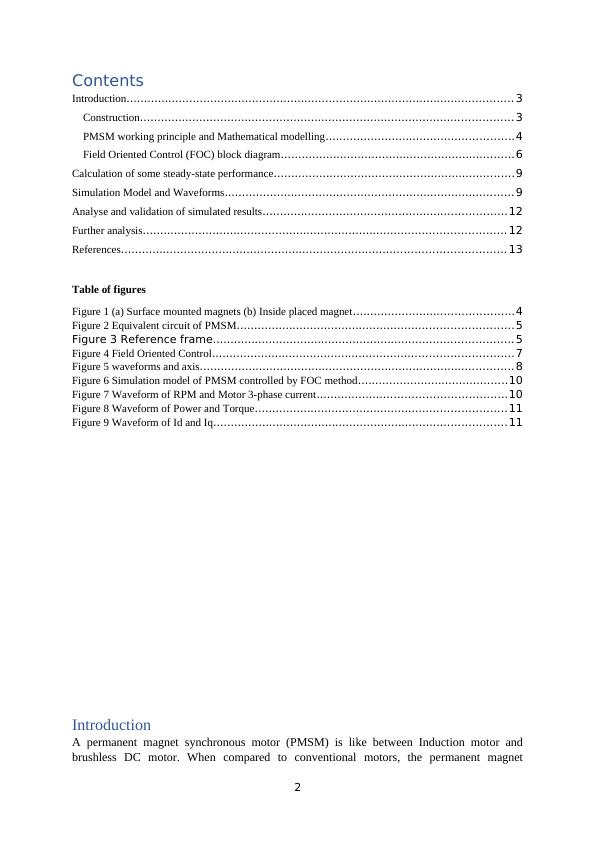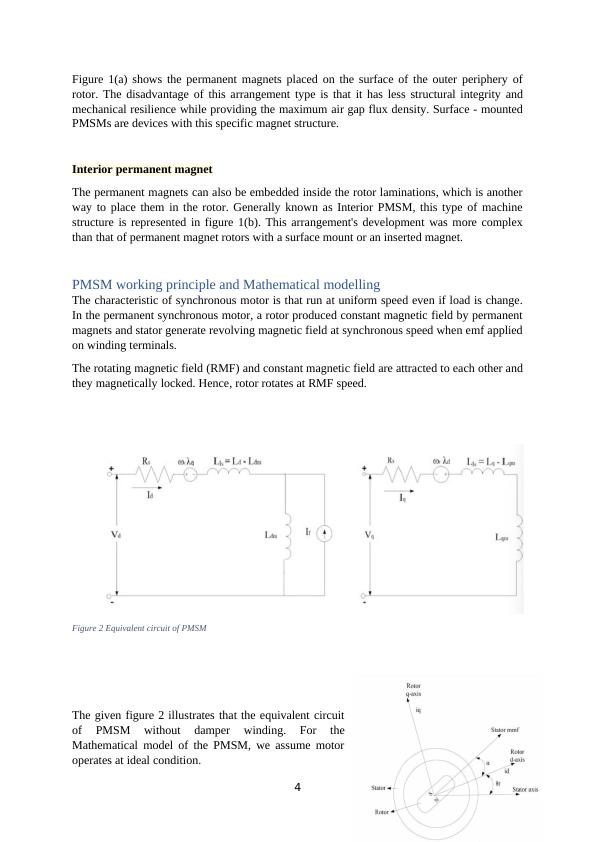42091: Advanced Energy Conversion Systems Assignment 2022
12 Pages1670 Words26 Views
Added on 2022-09-16
42091: Advanced Energy Conversion Systems Assignment 2022
Added on 2022-09-16
ShareRelated Documents
Advanced Energy Conversion Systems (42091)
Assignment: 1 (part 2)
Submitted to:
Submitted from
1
Assignment: 1 (part 2)
Submitted to:
Submitted from
1

Contents
Introduction............................................................................................................... 3
Construction........................................................................................................... 3
PMSM working principle and Mathematical modelling......................................................4
Field Oriented Control (FOC) block diagram...................................................................6
Calculation of some steady-state performance.....................................................................9
Simulation Model and Waveforms................................................................................... 9
Analyse and validation of simulated results......................................................................12
Further analysis........................................................................................................ 12
References.............................................................................................................. 13
Table of figures
Figure 1 (a) Surface mounted magnets (b) Inside placed magnet..............................................4
Figure 2 Equivalent circuit of PMSM............................................................................... 5
Figure 3 Reference frame...................................................................................... 5
Figure 4 Field Oriented Control...................................................................................... 7
Figure 5 waveforms and axis.......................................................................................... 8
Figure 6 Simulation model of PMSM controlled by FOC method...........................................10
Figure 7 Waveform of RPM and Motor 3-phase current......................................................10
Figure 8 Waveform of Power and Torque........................................................................11
Figure 9 Waveform of Id and Iq.................................................................................... 11
Introduction
A permanent magnet synchronous motor (PMSM) is like between Induction motor and
brushless DC motor. When compared to conventional motors, the permanent magnet
2
Introduction............................................................................................................... 3
Construction........................................................................................................... 3
PMSM working principle and Mathematical modelling......................................................4
Field Oriented Control (FOC) block diagram...................................................................6
Calculation of some steady-state performance.....................................................................9
Simulation Model and Waveforms................................................................................... 9
Analyse and validation of simulated results......................................................................12
Further analysis........................................................................................................ 12
References.............................................................................................................. 13
Table of figures
Figure 1 (a) Surface mounted magnets (b) Inside placed magnet..............................................4
Figure 2 Equivalent circuit of PMSM............................................................................... 5
Figure 3 Reference frame...................................................................................... 5
Figure 4 Field Oriented Control...................................................................................... 7
Figure 5 waveforms and axis.......................................................................................... 8
Figure 6 Simulation model of PMSM controlled by FOC method...........................................10
Figure 7 Waveform of RPM and Motor 3-phase current......................................................10
Figure 8 Waveform of Power and Torque........................................................................11
Figure 9 Waveform of Id and Iq.................................................................................... 11
Introduction
A permanent magnet synchronous motor (PMSM) is like between Induction motor and
brushless DC motor. When compared to conventional motors, the permanent magnet
2

synchronous motor's operation is incredibly simple, quick torque response with better
dynamic operation, and efficient.
Hence, PMSM is became one of the best choices for a wide range of motion control
applications. PMSM used in actuators, robotics, machine tools, traction applications and
electric vehicles. Usually, high-performance operation is possible with surface-mounted
magnets are fixed to a rotor, resulting in the minimal possible of armature effect with a wide
air gap.
Advantages and applications of PMSM:
Highly efficient and reliable
Construction and maintenance are easier than Induction motor
Smooth torque and maintaining full torque at low speed
Used in Air conditioners, refrigerators, electrical power steering of vehicles, data storage units and
many more.
Construction
The only structural difference between the permanent magnet synchronous motor and the
conventional synchronous motor is the rotor. Permanent magnets are used to create field
poles because the rotor without any field winding while conventional synchronous motor
requires rotor winding. Samarium-cobalt and medium, iron, and boron are employed to make
the permanent magnets used in the PMSM.
Magnets can be placed on the rotor's surface for operations at medium speeds or internal for
activities at high speeds, as shown in figure 1.
Figure 1 (a) Surface mounted magnets (b) Inside placed magnet
Surface-mounted PMSM
3
dynamic operation, and efficient.
Hence, PMSM is became one of the best choices for a wide range of motion control
applications. PMSM used in actuators, robotics, machine tools, traction applications and
electric vehicles. Usually, high-performance operation is possible with surface-mounted
magnets are fixed to a rotor, resulting in the minimal possible of armature effect with a wide
air gap.
Advantages and applications of PMSM:
Highly efficient and reliable
Construction and maintenance are easier than Induction motor
Smooth torque and maintaining full torque at low speed
Used in Air conditioners, refrigerators, electrical power steering of vehicles, data storage units and
many more.
Construction
The only structural difference between the permanent magnet synchronous motor and the
conventional synchronous motor is the rotor. Permanent magnets are used to create field
poles because the rotor without any field winding while conventional synchronous motor
requires rotor winding. Samarium-cobalt and medium, iron, and boron are employed to make
the permanent magnets used in the PMSM.
Magnets can be placed on the rotor's surface for operations at medium speeds or internal for
activities at high speeds, as shown in figure 1.
Figure 1 (a) Surface mounted magnets (b) Inside placed magnet
Surface-mounted PMSM
3

Figure 1(a) shows the permanent magnets placed on the surface of the outer periphery of
rotor. The disadvantage of this arrangement type is that it has less structural integrity and
mechanical resilience while providing the maximum air gap flux density. Surface - mounted
PMSMs are devices with this specific magnet structure.
Interior permanent magnet
The permanent magnets can also be embedded inside the rotor laminations, which is another
way to place them in the rotor. Generally known as Interior PMSM, this type of machine
structure is represented in figure 1(b). This arrangement's development was more complex
than that of permanent magnet rotors with a surface mount or an inserted magnet.
PMSM working principle and Mathematical modelling
The characteristic of synchronous motor is that run at uniform speed even if load is change.
In the permanent synchronous motor, a rotor produced constant magnetic field by permanent
magnets and stator generate revolving magnetic field at synchronous speed when emf applied
on winding terminals.
The rotating magnetic field (RMF) and constant magnetic field are attracted to each other and
they magnetically locked. Hence, rotor rotates at RMF speed.
Figure 2 Equivalent circuit of PMSM
The given figure 2 illustrates that the equivalent circuit
of PMSM without damper winding. For the
Mathematical model of the PMSM, we assume motor
operates at ideal condition.
4
rotor. The disadvantage of this arrangement type is that it has less structural integrity and
mechanical resilience while providing the maximum air gap flux density. Surface - mounted
PMSMs are devices with this specific magnet structure.
Interior permanent magnet
The permanent magnets can also be embedded inside the rotor laminations, which is another
way to place them in the rotor. Generally known as Interior PMSM, this type of machine
structure is represented in figure 1(b). This arrangement's development was more complex
than that of permanent magnet rotors with a surface mount or an inserted magnet.
PMSM working principle and Mathematical modelling
The characteristic of synchronous motor is that run at uniform speed even if load is change.
In the permanent synchronous motor, a rotor produced constant magnetic field by permanent
magnets and stator generate revolving magnetic field at synchronous speed when emf applied
on winding terminals.
The rotating magnetic field (RMF) and constant magnetic field are attracted to each other and
they magnetically locked. Hence, rotor rotates at RMF speed.
Figure 2 Equivalent circuit of PMSM
The given figure 2 illustrates that the equivalent circuit
of PMSM without damper winding. For the
Mathematical model of the PMSM, we assume motor
operates at ideal condition.
4

End of preview
Want to access all the pages? Upload your documents or become a member.
Related Documents
Impact on the performance of permanent magnet synchronous engines due to direct torque control and field-oriented controllg...
|7
|2597
|54
8. Sensorless Control of Permanent Magnet Synchronous Motor Assignment 2022lg...
|71
|12072
|20
Assignment for Advanced Energy Conversion Systems (42091)lg...
|15
|2004
|18
Theoretical Background Electrical Engineeringlg...
|9
|1452
|51
Advance Electrical Machines and Driveslg...
|39
|6447
|5
The electrical and electronic controllg...
|10
|1305
|13
